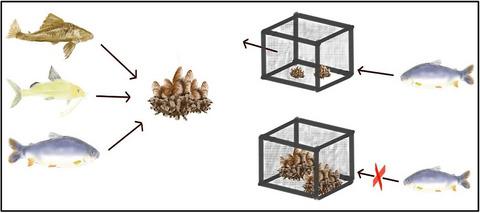当前位置:
X-MOL 学术
›
J. Appl. Ecol.
›
论文详情
Our official English website, www.x-mol.net, welcomes your
feedback! (Note: you will need to create a separate account there.)
Evaluating the role of predatory fish controlling the invasion of the Asian golden mussel Limnoperna fortunei in a subtropical river
Journal of Applied Ecology ( IF 5.0 ) Pub Date : 2020-03-06 , DOI: 10.1111/1365-2664.13573 Ivan González‐Bergonzoni 1, 2, 3 , Ivana Silva 1, 2, 3 , Franco Teixeira de Mello 4 , Alejandro D'Anatro 2 , Lucia Boccardi 5 , Samanta Stebniki 2 , Ernesto Brugnoli 6 , Giancarlo Tesitore 4 , Nicolás Vidal 2 , Daniel E. Naya 2
中文翻译:

评价掠夺性鱼类在亚热带河流域控制亚洲金贻贝Limnoperna fortunei入侵的作用
更新日期:2020-03-06
Journal of Applied Ecology ( IF 5.0 ) Pub Date : 2020-03-06 , DOI: 10.1111/1365-2664.13573 Ivan González‐Bergonzoni 1, 2, 3 , Ivana Silva 1, 2, 3 , Franco Teixeira de Mello 4 , Alejandro D'Anatro 2 , Lucia Boccardi 5 , Samanta Stebniki 2 , Ernesto Brugnoli 6 , Giancarlo Tesitore 4 , Nicolás Vidal 2 , Daniel E. Naya 2
Affiliation

|
- The invasive Asian golden mussel Limnoperna fortunei is continuously expanding through South America, altering aquatic ecosystem structure and functioning. While several native fish species predate on this mussel, these interactions, and their consequences for the food web, have not been studied in depth.
- We combine a survey of the fish assemblage trophic structure using gut contents and stable isotope analysis with an in situ exclusion experiment in order to: (a) determine the main fish species predating on L. fortunei; (b) estimate the contribution of L. fortunei to the biomass of fish assemblage; and (c) evaluate the role of fish on the density and maximum shell length of L. fortunei in the lower Uruguay River (the Río de La Plata Basin).
- We found that about one third of fish species in the assemblage (28 out of 81 species) consumed L. fortunei, which was an important food item (>10% of the dietary volume and >30% of frequency of occurrence) for 11 fish species. Stable isotope mixing models consistently suggested that >14% of the total biomass of the fish assemblage was derived directly from carbon derived from L. fortunei tissues. In addition, the exclusion experiment demonstrated that fish predation reduces the mussel density by c. 70% and the mussel maximum shell length by c. 40%.
- Synthesis and applications. Our research suggests a top‐down effect of fish on the invasive Asian golden mussel's abundance. This work highlights the need to preserve the native fish communities, particularly in South America, where many vulnerable migratory fish are of key relevance as Limnoperna fortunei consumers. In the light of these findings, actions such as implementing efficient fish passage technologies in the actual (and projected) dams of the Uruguay River basin and elsewhere become essential to avoid local extinctions of these natural invasion controls upstream of the dams.
中文翻译:

评价掠夺性鱼类在亚热带河流域控制亚洲金贻贝Limnoperna fortunei入侵的作用
- 外来入侵的亚洲金贻贝Limnoperna fortunei正在南美不断扩展,改变了水生生态系统的结构和功能。尽管有几种本地鱼类早于这种贻贝,但尚未深入研究这些相互作用及其对食物网的影响。
- 我们使用的肠道内容物和稳定同位素分析,以便结合鱼类群落营养结构的调查与原位排除实验:(1)确定的主要鱼类捕食对L.扶芳藤; (b)估算福氏乳酸菌对鱼群生物量的贡献;(c)评价鱼类对乌拉圭河下游(拉普拉塔河盆地)的福氏乳杆菌密度和最大壳长的影响。
- 我们发现,该组合中约有三分之一的鱼类(81种鱼类中的28种)食用了福氏乳杆菌(L. fortunei),这是11种鱼的重要食品(日粮量的10%以上,发生频率的30%以上)种类。稳定的同位素混合模型始终表明,鱼类组合中总生物量的> 14%直接来自于福氏乳杆菌组织中的碳。此外,排除实验表明,捕食鱼类会降低贻贝的密度达c。贻贝的最大壳长为70%,约为c。40%。
- 综合与应用。我们的研究表明,鱼类对入侵性亚洲金贻贝的丰度具有自顶向下的作用。这项工作强调了保护本地鱼类群落的必要性,特别是在南美,南美许多脆弱的迁徙鱼类与Limnoperna fortunei消费者息息相关。根据这些发现,在乌拉圭河流域和其他地方的实际(和计划中)大坝中实施有效的鱼类通过技术等行动,对于避免这些大坝上游自然入侵控制措施的局部灭绝至关重要。











































 京公网安备 11010802027423号
京公网安备 11010802027423号